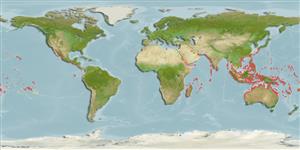Common names from other countries
>
Centrarchiformes (Basses) >
Kuhliidae (Aholeholes)
Etymology: Kuhlia: Because of Heindrich Kuhl, 1797-1821; researcher also with lizards (Gekkonidae).
More on author: Forster.
Environment: milieu / climate zone / depth range / distribution range
экология
морской; солоноватоводный ассоциированный с рифами; пределы глубины 3 - 18 m (Ref. 5227). Tropical; 32°N - 32°S
Indo-Pacific and Eastern Pacific: Red Sea and East Africa to the eastern Pacific, north to southern Japan, south to New South Wales and Lord Howe Island. Absent from Easter Island, Pitcairn, Marquesas, Hawaiian Islands and Johnston Island.
Size / Вес / Возраст
Maturity: Lm ? range ? - ? cm
Max length : 40.0 cm SL самец/пол неопределен; (Ref. 4967); common length : 20.0 cm TL самец/пол неопределен; (Ref. 30573)
колючие лучи спинного плавника (общее число) : 10; членистые (мягкие) лучи спинного плавника (общее число) : 10 - 11; колючие лучи анального плавника: 3; членистые (мягкие) лучи анального плавника: 10 - 12. Preorbital serrae 11-14; body depth 2.75-3.05 in SL; caudal concavity 1.85-2.6 in head length; Silvery, the front of snout and chin blackish; caudal fin white with a median dark stripe and two broad oblique black bands across each lobe, the lobe tips white; a dusky band in outer part of soft portion of dorsal fin except for white tip of high anterior part. Juveniles (2.0-3.0 cm SL) have the median and outer black bands in the caudal fin lobes, but the middle band is represented only by a black spot basally in the outer part of each lobe (Ref. 41640).
Tightly packed schools occur along the reef margin of rocky shorelines, from just below the breaking surf to a depth of a few meters. Young commonly in tide pools (Ref. 41640). Sometimes found in estuaries but reported to never enter freshwater environments (Ref. 41640). Feeds on free-swimming crustaceans and small fishes at night (Ref. 5213). Utilized fresh or dried salted (Ref. 7271).
Life cycle and mating behavior
Maturities | размножение | Spawnings | Egg(s) | Fecundities | личинки
Randall, J.E. and H.A. Randall, 2001. Review of the fishes of the genus Kuhlia (Perciformes: Kuhliidae) of the Central Pacific. Pac. Sci. 55(3):227-256. (Ref. 41640)
Статус Красного Списка МСОП (Ref. 130435)
CITES (Ref. 128078)
Not Evaluated
Угроза для людей
Harmless
Использование человеком
рыболовство: не имеет хозяйственного значения; аквариум: общественные аквариумы; наживка: usually
дополнительная информация
инструменты
Специальные отчеты
Скачать в формате XML
ресурсы в Интернет
Estimates based on models
Preferred temperature (Ref.
115969): 24.5 - 29.3, mean 28.3 (based on 3387 cells).
Phylogenetic diversity index (Ref.
82804): PD
50 = 0.5002 [Uniqueness, from 0.5 = low to 2.0 = high].
Bayesian length-weight: a=0.01413 (0.00591 - 0.03375), b=3.06 (2.86 - 3.26), in cm Total Length, based on LWR estimates for this (Sub)family-body shape (Ref.
93245).
Trophic level (Ref.
69278): 3.8 ±0.60 se; based on food items.
устойчивость к внешним воздействиям (Ref.
120179): низкий, минимальное время удвоения популяции 4.5-14 лет (Preliminary K or Fecundity.).
Fishing Vulnerability (Ref.
59153): Moderate vulnerability (39 of 100).
